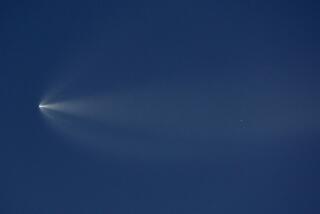Navy launches drone from an underwater submarine
- Share via
The Navy has launched a drone from a submerged submarine, a feat that could prove valuable in providing intelligence and reconnaissance capabilities for military special operations for decades to come.
The small drone was fired from the Providence submarine’s torpedo tube, where it unfolded its wings, took off and flew a “several hour” mission demonstrating live video capabilities streamed back to the sub, the Navy said.
The project, which took $15 million and about six years to accomplish, was carried out by the Naval Research Laboratory. It took place at the Navy’s Atlantic Undersea Test and Evaluation Center in the Bahamas.
“This six-year effort represents the best in collaboration of a Navy laboratory and industry to produce a technology that meets the needs of the special operations community,” Warren Schultz, program developer and manager with the Naval Research Laboratory, said in a statement. “The creativity and resourcefulness brought to this project by a unique team of scientists and engineers represents an unprecedented paradigm shift.”
The drone, known as the experimental fuel cell unmanned aerial system, or XFC, is an all-electric, autonomous aircraft that can fly more than six hours at a time.
It’s put into a container for launch and is blasted through a torpedo tube typically used for launching Tomahawk cruise missiles.
To take off, the drone uses an electrically assisted system, which lifts the plane vertically out of the container, allowing its folding wings to spring out.
The research program was a proof of concept and not a program of record, the Navy said. There is no next phase.
The flight marks another big milestone for the Navy, which in July launched and landed a drone on an aircraft carrier for the first time.
ALSO:
Rocket roars to life at Vandenberg with secret orbital payload SpaceX reaches milestone in rocket launch from Cape Canaveral
Global Hawk drone flies into budget battle between Pentagon, Congress
More to Read
Inside the business of entertainment
The Wide Shot brings you news, analysis and insights on everything from streaming wars to production — and what it all means for the future.
You may occasionally receive promotional content from the Los Angeles Times.











